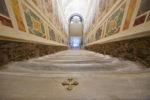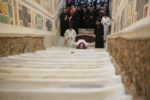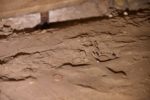 The 28 white marble stairs said to have been trod upon by Jesus during his trial before Pontius Pilate have been unveiled for the first time in three centuries. Church tradition holds that the staircase led to the prætorium of Pilate and was brought from Jerusalem to Rome by Helen, mother of Constantine, in 326 A.D.
The 28 white marble stairs said to have been trod upon by Jesus during his trial before Pontius Pilate have been unveiled for the first time in three centuries. Church tradition holds that the staircase led to the prætorium of Pilate and was brought from Jerusalem to Rome by Helen, mother of Constantine, in 326 A.D.
(There’s no way they were the authentic prætorium stairs, just for the record. There was no marble in Palestine, and Rome would certainly have not gone to the expense of importing the high quality Aegean marble these stairs were made of for a backwater governor’s headquarters. Besides, Titus destroyed Jerusalem in 70 A.D., Pilate’s prætorium included. Helen was sold many, many “relics” on her tour of the Holy Land.)
They were installed in the Lateran Palace, the ancient domus of the Plautii Laterani family on the Caelian Hill which was given to the Pope by Constantine around 313 A.D., leading up to a hall near the Chapel of St. Sylvester. They were protected with a dedicated roof and regular steps were built on either side for non-ceremonial use.
The Lateran Palace was the primary residence of the popes until the 14th century when the papal court was moved to Avignon. By the time the long Babylonian Captivity was over and the papacy returned to Rome in 1377, the Lateran had suffered extensive damage in two major fires and the popes looked elsewhere for digs, eventually winding up in the Vatican.
Today, the Scala Sancta leads to the Sancta Sanctorum, the first private papal chapel which is known as the Holiest of Holies due to the numerous relics secreted there none of which have been seen since the early 16th century. The sanctuary is one of several buildings of the Lateran complex which includes the palace and the Basilica of St. John in Lateran, the titular seat of the Bishop of Rome. The Sancta Sanctorum is the only surviving section of the original ancient Lateran Palace, demolished by Pope Sixtus V in 1586 to make way for the much smaller one that stands there today. (Sixtus V was notorious for razing ancient monuments to the ground for use as raw material in his ambitious programs of architectural modernization.) He had the steps moved to the base of the Sancta Sanctorum and opened them to the public for the first time.
 The steps and chapel became a major site of pilgrimage, with pilgrims ascending the stairs on their knees, kissing three spots marked with a cross said to be stained with droplets of Christ’s blood. So many pilgrim knees rubbed against the marble that they eroded deep troughs across the full width of each step. To keep the stairs from whittling down to nothing, in 1723 Innocent XIII had them covered them with walnut wood for their protection. Those casings remained in place for close to 300 years.
The steps and chapel became a major site of pilgrimage, with pilgrims ascending the stairs on their knees, kissing three spots marked with a cross said to be stained with droplets of Christ’s blood. So many pilgrim knees rubbed against the marble that they eroded deep troughs across the full width of each step. To keep the stairs from whittling down to nothing, in 1723 Innocent XIII had them covered them with walnut wood for their protection. Those casings remained in place for close to 300 years.
 Restoration of the Holy Stairs began in January of 2018. Both the marble and the wood coverings required conservation, as did the frescoes on the side walls, so the Scala Sancta has been closed since work began. When restorers removed the wood, they were surprised to find deep furrows in the center of the steps. They realized these marks were left by the tips of millions of pilgrim shoes pushing up to the next step.
Restoration of the Holy Stairs began in January of 2018. Both the marble and the wood coverings required conservation, as did the frescoes on the side walls, so the Scala Sancta has been closed since work began. When restorers removed the wood, they were surprised to find deep furrows in the center of the steps. They realized these marks were left by the tips of millions of pilgrim shoes pushing up to the next step.
The conservation of the wood is not finished yet. The work on the marble steps, however, is complete, so Church authorities decided to open them to the public for a very short period from April 11th until June 9th, the day of Pentecost. Orthopedists can go ahead and buy that new Mercedes, because pilgrims are flocking to the Scala Sancta to take advantage of the opportunity. Oh, and there are plenary indulgences on the line for anyone who goes up the stairs on the knees in prayer after taking Communion and Confession.
Three medieval crosses, set into the marble to commemorate that event, will now become visible again: the first in porphyry at the beginning of the staircase, another in bronze at the end, and the third on the eleventh stair, where according to tradition Jesus fell, breaking the marble with His knee.
Under the technical and scientific direction of the Vatican Museums, with the contribution of the Patrons of the Arts in the Vatican Museums, the restorers have brought to light the ancient marble, gathering from under the wooden cover a multitude of written notes, ex voto, coins and photographs left by the faithful, and now conserved by the Passionist Fathers who since 1853 have safeguarded the Shrine, at the behest of Pope Pius IX.
Just to make it clear: Personally, I wont go anywhere without my high quality Aegean marble stairs! 😎